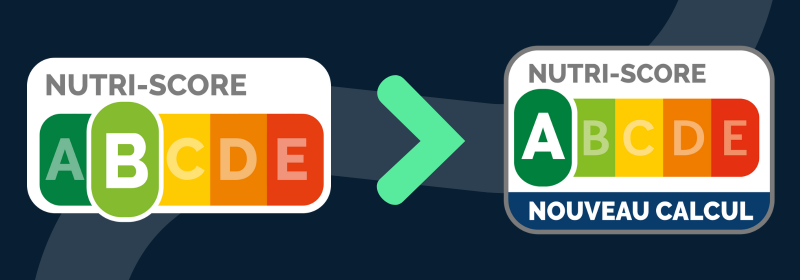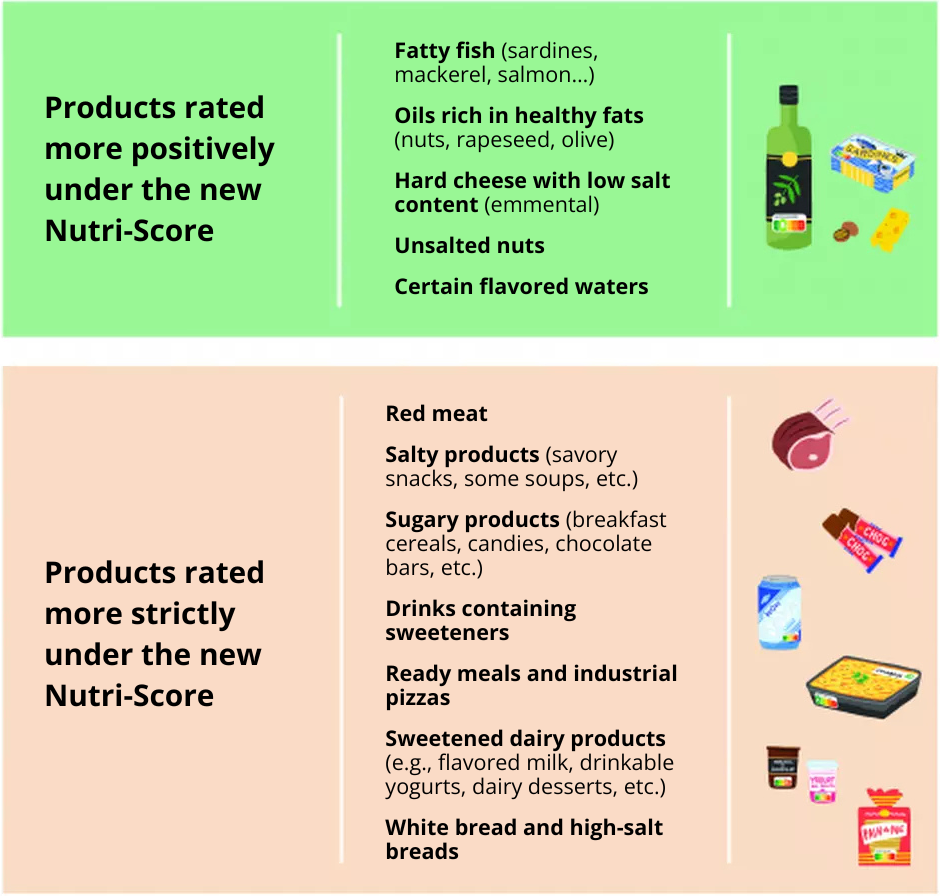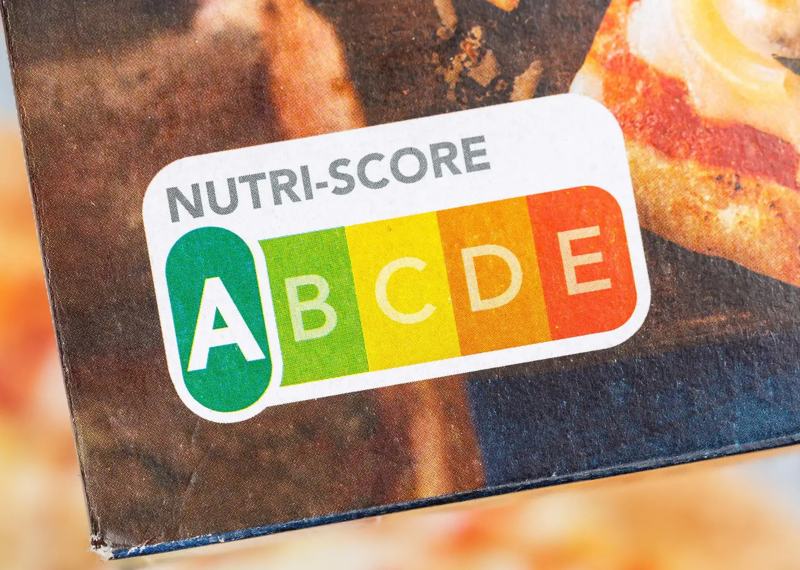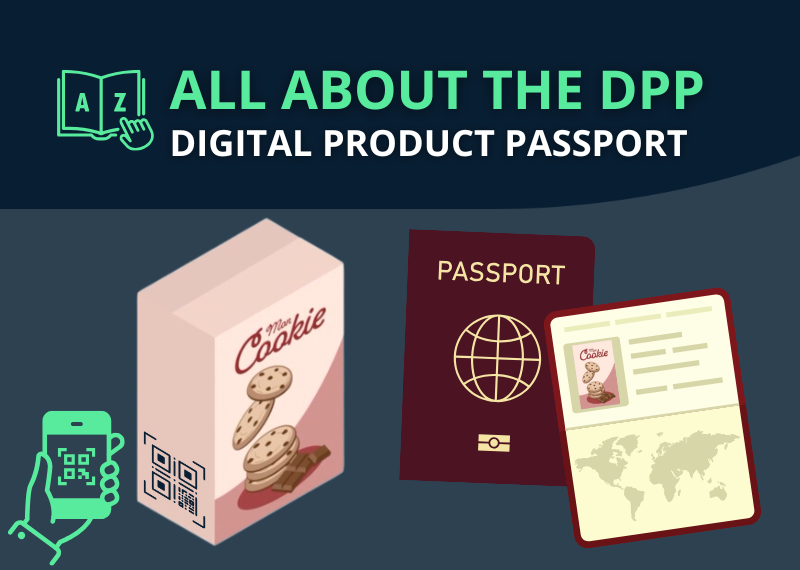Table of contents
The Nutri-Score is evolving. Since March 2025, a new version of this well-known nutritional label has come into effect. Stricter and better aligned with European dietary recommendations, this next-generation Nutri-Score is set to transform how food companies operate.
In this article, we’ll cover:
- What the Nutri-Score is
- What’s changing in 2025
- What it means for brands and retailers
- And how to adapt quickly and efficiently
Reminder: What is the Nutri-Score?
Launched in France in 2017 as part of a health system modernization law, the Nutri-Score has become a key tool to help consumers make healthier food choices. This colored nutritional labeling system is affixed to the front of packaging to provide a quick and easy way of reading the overall nutritional quality of a product. It classifies food products into 5 levels, from A (green) to E (red), according to their overall nutritional value.
The goal? To help consumers recognize the overall nutritional quality of food, right from the moment of purchase. And in so doing, combat chronic diseases linked to poor nutrition.

Why a new Nutri-Score?
Modern eating habits – high in processed foods, saturated fats, salt, and added sugars – are now recognized as major risk factors for chronic diseases such as diabetes, cardiovascular issues, and obesity.
While prevention campaigns play an important role, having clear information at the point of purchase is just as crucial. That’s where the Nutri-Score comes in: a simple and effective visual indicator, placed directly on the packaging, allowing consumers to make informed choices independently.
Nutri-Score 2.0: What’s changing?
The updated Nutri-Score aims to amplify its impact by incorporating the latest scientific guidelines. Here’s what’s new:
A stricter scoring system:
- Products high in sugar, salt, saturated fats, or red meat will receive lower scores.
- In contrast, items rich in fiber or protein will benefit from improved ratings.
- This revision affects around 30-40% of food products currently on the market.
- A label indicating “new calculation” will appear on packages assessed under the updated criteria.

Nutri-Score 2.0 officially took effect in France on March 16, 2025. Brands have a two-year transition period to update their packaging, with a deadline set for early 2027.
Nutri-Score expands across Europe and internationally
Originating in France, the Nutri-Score has since won over several other countries. It is gradually being introduced across Europe:
- Officially adopted by six European countries: Germany, Spain, Belgium, the Netherlands, Luxembourg, and Switzerland.
- Under consideration in countries like Finland and the United Arab Emirates.
- Italy, on the other hand, is opposed to the idea, arguing that it would have a negative impact on some of its traditional gastronomic products.
What are the impacts for retailers and manufacturers?
En renforçant les critères de notation, cette évolution pousse les marques à plus de transparence dans la formulation, mais aussi dans la communication de la qualité nutritionnelle de leurs produits. Désormais, le score affiché sur l’emballage reflète plus fidèlement l’équilibre global de la recette – sucre, sel, matières grasses, fibres, protéines… rien n’échappe à l’analyse.
The rollout of the new Nutri-Score is far more than a packaging update – it redefines the rules of the game for the entire food industry. By tightening the scoring criteria, Nutri-Score 2.0 pushes brands to be more transparent, both in product formulation and in communicating nutritional quality. The score displayed now offers a more accurate reflection of the product’s overall balance – sugar, salt, fat, fiber, protein – no information escapes the analysis.
But this increased demand also presents a real opportunity for transformation. It encourages manufacturers to reformulate their products with healthier ingredients. This new framework encourages a dynamic of continuous improvement for the benefit of consumers. The Nutri-Score thus becomes a strategic lever for brands aiming to meet growing expectations for transparency.
However, this transition brings operational challenges – especially in logistics and product information management. Thousands of product sheets need to be updated across multiple markets, under tight deadlines, while ensuring data accuracy and compliance.
What are the solutions to adapt quickly?
For food and retail companies, updating product sheets to comply with the 2025 Nutri-Score is a major challenge. Managing thousands of SKUs and integrating this new data accurately and efficiently can quickly become overwhelming…
Unless you have the right tools.
As a Product Information Management (PIM) solution, Equadis helps clients turn this regulatory challenge into a growth opportunity.
With the Equadis PIM, empowered by Artificial Intelligence, we allow our clients to:
- Automatically fill in product information, at scale – including the updated Nutri-Score
- Accelerate the data entry and validation process with AI
- Ensure smooth and fast compliance without overloading teams
- Centralize, enrich, and distribute data across all channels (physical stores, e-commerce platforms, marketplaces, internal tools, consumer apps, etc.)
Enriched, reliable and up-to-date product information, ready for distribution across all your sales channels, both physical and online. Controlled compliance, reduced time-to-market, and above all: a stronger brand image with consumers through greater transparency.



